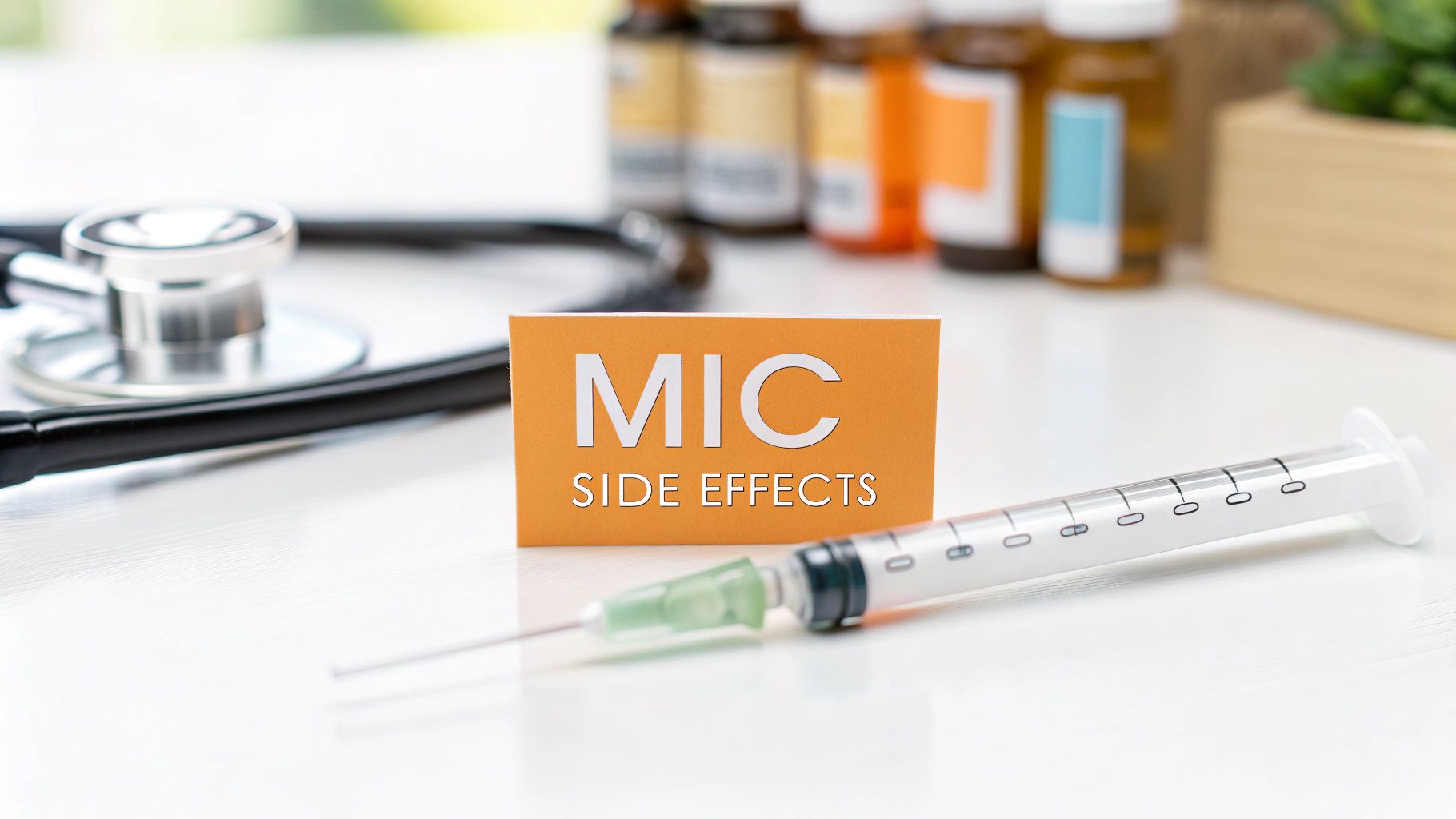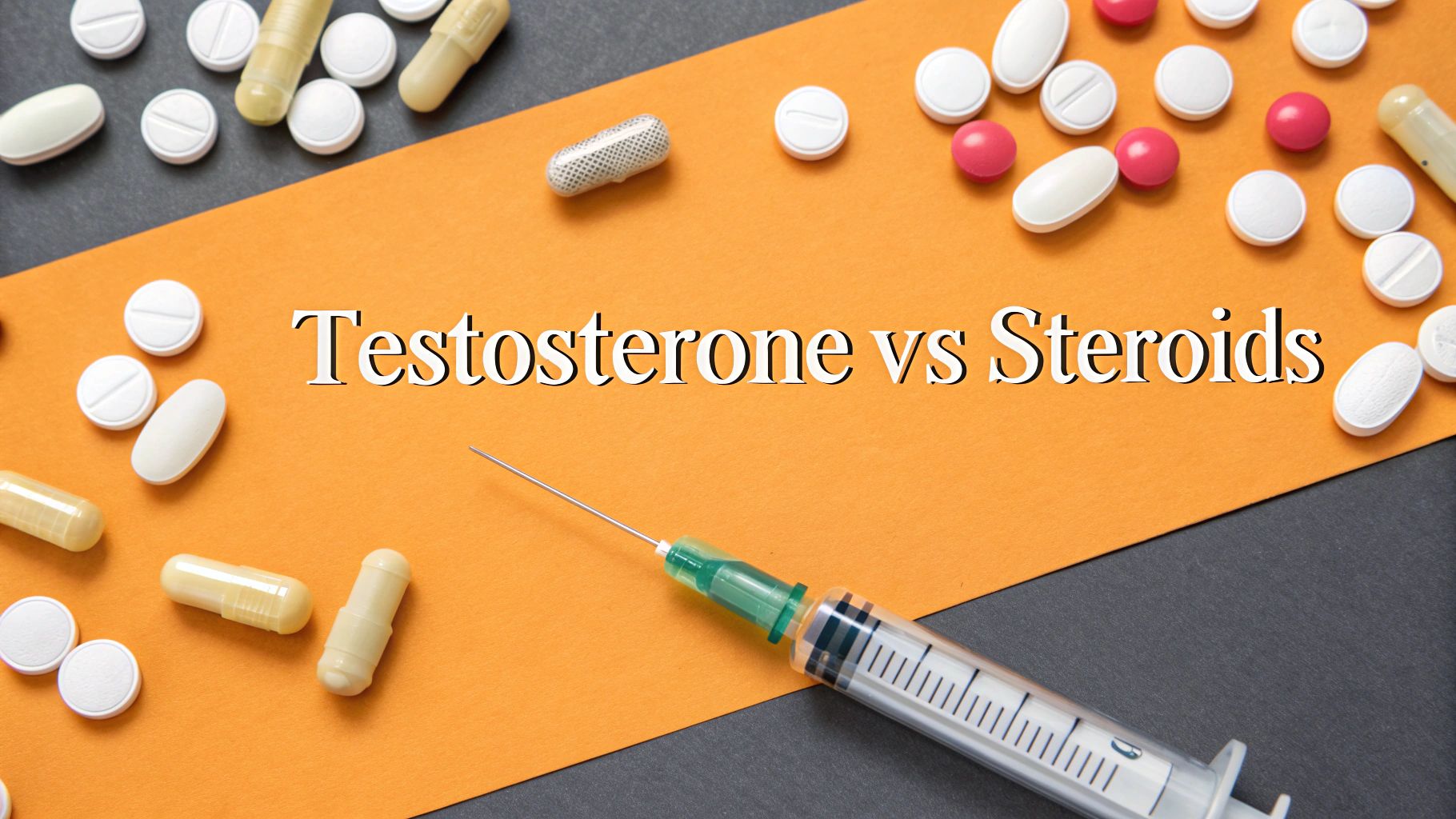You’ve probably heard a lot of talk about new weight loss drugs lately. What you might not realize is that you’re hearing about the power of peptides. These aren’t some strange, synthetic compounds; they are short chains of amino acids that your body already uses as powerful messengers, telling it how to function.
Think of them as highly specialized keys. They’re designed to fit perfectly into specific locks within your body—in this case, the ones that control your appetite and metabolism. The recent buzz is all about how we can use these “keys” to unlock your body’s innate ability to manage weight.
Understanding the Rise of Peptides in Weight Loss
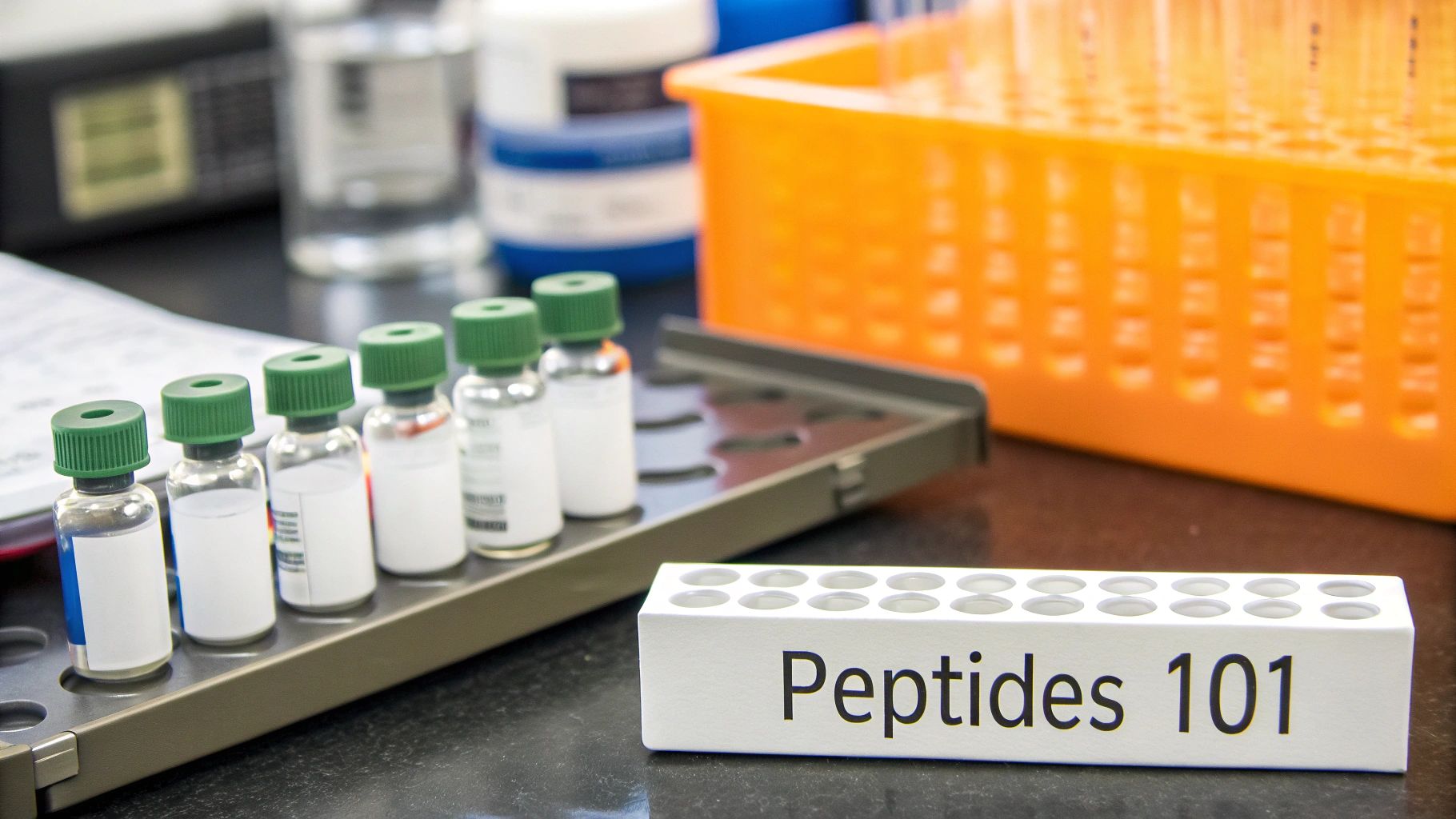
So, how exactly do these peptides work their magic? It’s a beautifully simple concept. Certain peptides perfectly mimic the hormones your gut naturally releases after you eat.
This process sends a direct signal to your brain, essentially saying, “Hey, we’re full down here!” It effectively turns down the volume on hunger pangs and persistent cravings. It’s like having an internal appetite moderator that helps you feel satisfied with smaller portions, making it easier to stick to your goals without a constant battle against hunger.
What makes this approach so compelling is that it works with your body, not against it. Unlike old-school stimulants that often come with jittery side effects, peptides harmonize with your natural biological systems. This synergy is a major reason why they’ve become a cornerstone of modern medical weight management.
The Science Behind the Surge
The recent explosion in popularity isn’t just hype. It’s built on a solid foundation of science and incredible real-world results. The driving force behind this movement is a class of peptides known as GLP-1 (glucagon-like peptide-1) receptor agonists.
These were first developed to help manage diabetes, but their powerful effect on weight loss quickly became the main event. Researchers and patients saw that people weren’t just getting better blood sugar control; they were also losing significant weight.
This effectiveness has fueled staggering market growth. The global GLP-1 market, which was valued at around $20.88 billion, is now projected to soar to $31.27 billion. That kind of financial momentum reflects massive clinical confidence and patient demand. You can read more about the GLP-1 market’s rapid growth and see just how significant this trend is.
At its heart, peptide therapy is about tapping into your body’s own communication system. By introducing specific peptides, we can amplify the natural signals for fullness, hunger, and metabolism, making sustainable weight management a much more achievable goal.
A Quick Look at Leading Weight Loss Peptides
To help you get a clearer picture, here’s a quick rundown of the most popular and effective peptides used for weight management today. Each has a unique way of working with your body.
| Peptide | Primary Mechanism | Main Benefit |
|---|---|---|
| Semaglutide | Mimics the GLP-1 hormone | Strong appetite suppression and blood sugar control |
| Tirzepatide | Mimics both GLP-1 and GIP hormones | Potent weight loss and enhanced metabolic benefits |
| Liraglutide | A once-daily GLP-1 hormone mimic | Effective appetite control with a shorter duration |
| CJC-1295/Ipamorelin | Stimulates growth hormone release | Promotes fat loss and preserves lean muscle mass |
While GLP-1-based peptides like Semaglutide and Tirzepatide are famous for curbing appetite, others like CJC-1295/Ipamorelin work differently by helping your body burn fat while holding onto precious muscle. Understanding these differences is key to finding the right path for your specific goals.
How Peptides Tell Your Body to Lose Weight
You don’t need a biochemistry degree to grasp how weight-loss peptides work. At its heart, it’s all about communication. Peptides are essentially tiny messengers that give your body very specific instructions—think of a traffic cop directing cars to slow down, stop, or take a detour.
Imagine your digestive system as a busy highway. When you eat, food is the traffic. Peptides like Semaglutide, which belong to a class called GLP-1 receptor agonists, act as those traffic cops. They send clear, direct signals to both your brain and your gut, fundamentally changing how your body handles the traffic from the food you eat.
What makes this so effective is that these peptides aren’t introducing some foreign concept. They simply amplify the natural messages your body already uses to manage hunger, fullness, and energy.
The Three Pillars of Peptide Action
The power of these peptides really comes down to a three-pronged approach. Each mechanism is distinct, but they all work together to create a significant, positive impact on your appetite and metabolism.
- Slowing Down Digestion
One of the first things these peptides do is gently hit the brakes on your stomach. This process, known as slowing gastric emptying, controls how quickly food moves from your stomach into your small intestine. Picture a dam releasing water slowly and steadily instead of all at once. This simple change means food sits in your stomach longer, which helps you feel physically full for hours after a meal. - Signaling the Brain
At the same time, these peptide messengers travel up to your brain and connect with receptors in the hypothalamus, the part of your brain that acts as the command center for hunger. They deliver a very clear message: “We’re full. We’ve got enough fuel. You can stop eating.” This direct line to your brain’s satiety center is incredibly powerful for shutting down cravings and reducing the mental urge to overeat. - Fine-Tuning Blood Sugar
Finally, GLP-1 agonists help your body manage blood sugar with much greater efficiency. They prompt your pancreas to release the right amount of insulin when blood sugar rises, helping your cells use that sugar for immediate energy rather than storing it away as fat. This improved insulin sensitivity is key to preventing the frustrating blood sugar spikes and crashes that send you running for a sugary snack.
The Lock and Key Analogy
The way a peptide interacts with a cell is incredibly precise—it’s just like a key fitting into a specific lock. Your body has countless cellular “locks” called receptors, and each peptide is a uniquely shaped “key” that only fits the right ones.
GLP-1 receptor agonists are keys designed exclusively for the “GLP-1” locks found in your gut, pancreas, and brain. When the peptide key slides into the receptor lock, it triggers a cascade of biological actions.
This precise targeting is what makes peptide therapy so powerful. It doesn’t just flood your system with random signals; it delivers a targeted message to the exact cells responsible for regulating appetite and metabolism, leading to a more natural and controlled weight loss process.
By activating these specific pathways, your body is gently nudged toward a state of better metabolic balance. The result is a multi-angled approach that tackles weight loss from every critical direction. For a closer look, our guide on understanding appetite regulation and how peptides can help control cravings goes into even greater detail.
This targeted action means you’re not just eating less because you’re forcing yourself through sheer willpower. You’re eating less because your body is genuinely telling you it’s satisfied. That fundamental shift is what sets peptide-assisted weight loss apart from traditional dieting, which so often feels like a constant battle against your own body. With peptides, you’re finally working with your body, not against it.
A Guide to the Most Effective Peptides
When you start looking into peptides for weight loss, you’ll find it’s a field with several major players. While they all aim for the same result, they get there through different biological routes. Getting a handle on these differences is key to having a smart conversation with your doctor about what will work best for your body and your goals.
Some of these, like the GLP-1 and dual-action agonists, have practically become household names. But others take a different angle, like targeting growth hormone release, offering unique benefits. Let’s walk through the most common options.
The image below gives a great overview of the main ways these peptides help you manage your weight, from firing up your metabolism to curbing hunger and burning fat.
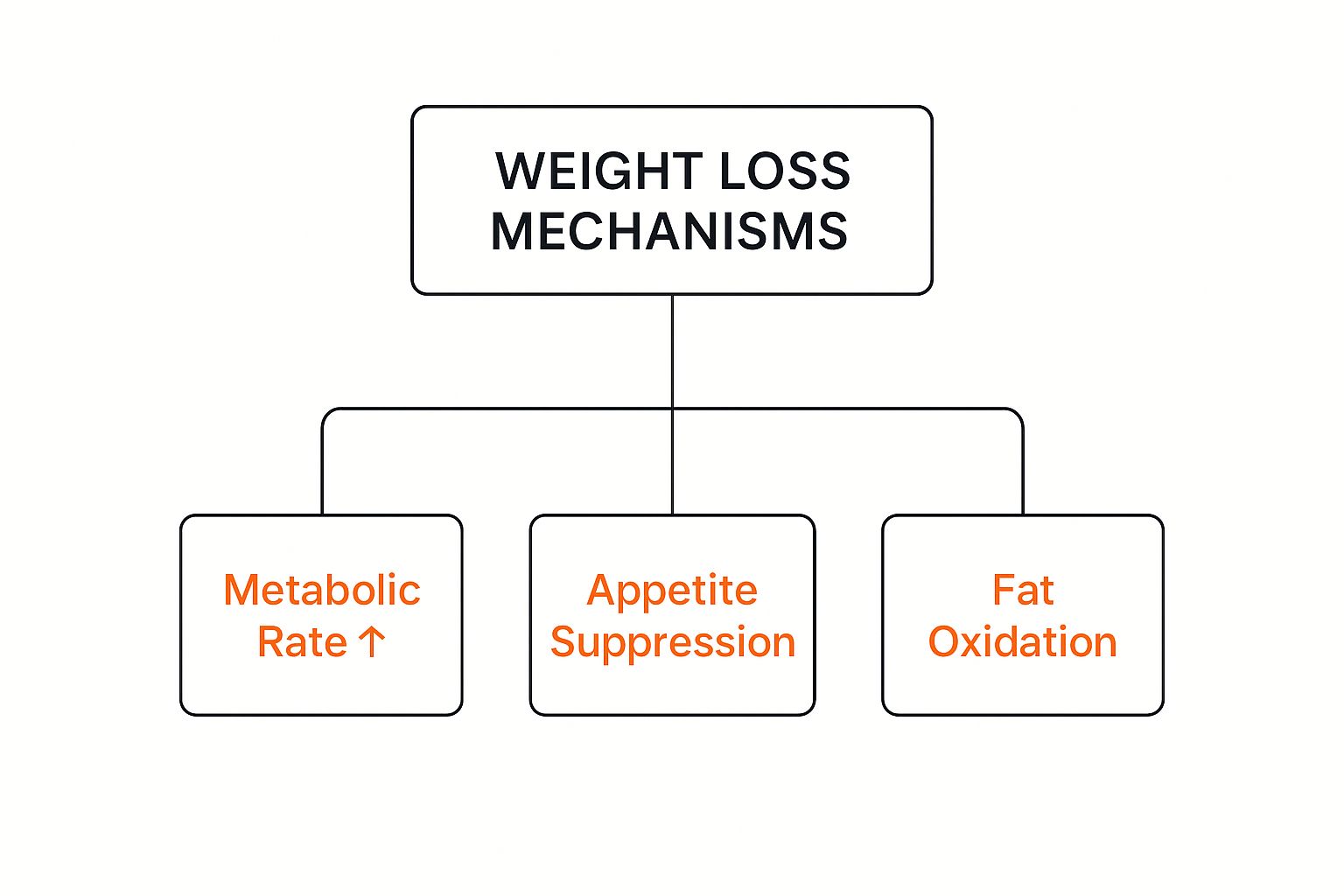
As you can see, the real power comes from tackling the problem from multiple angles at once—metabolism, hunger, and fat breakdown.
Semaglutide: The Appetite Suppressor
You’ve probably heard of Semaglutide. It’s a powerhouse GLP-1 receptor agonist. The best way to think about it is as a master impersonator. It perfectly mimics the natural GLP-1 hormone your gut produces after you eat, which sends powerful “I’m full” signals to your brain.
This simple action drastically cuts down your appetite. It also slows the rate at which your stomach empties, so you feel satisfied for much longer with less food. Plus, its once-weekly injection schedule is a huge convenience for many people. It’s no surprise that Semaglutide has become a go-to for medical weight management.
Tirzepatide: The Dual-Action Powerhouse
Tirzepatide, the key ingredient in drugs like Mounjaro and Zepbound, is a major leap forward. It doesn’t just mimic one hormone—it mimics two. As a dual-agonist, Tirzepatide hits both GLP-1 and GIP (glucose-dependent insulinotropic polypeptide) receptors.
Imagine you have two different keys that unlock two separate doors, but both lead to significant weight loss. That’s Tirzepatide. By activating both of these pathways, it often leads to even better results than GLP-1 agonists can achieve on their own. The GIP action works alongside the GLP-1 effects to improve how your body handles sugar and fat, delivering a one-two punch for metabolic health.
The skyrocketing demand for these peptides speaks for itself. The market for GLP-1 agonists for weight loss was valued at around $13.38 billion and is projected to climb much higher. This growth shows just how much trust clinicians and patients are placing in these treatments. You can discover more insights about the GLP-1 drug market to grasp the full scale of this trend.
Other Important Peptides to Know
Beyond the big names, a few other peptides play crucial roles, especially when you’re aiming for a more complete approach to changing your body composition.
- Liraglutide: This is another GLP-1 receptor agonist and one of the first peptides approved for weight management. It works much like Semaglutide but requires a once-daily injection, which some people might find fits their routine better.
- CJC-1295/Ipamorelin: This duo is completely different. Instead of targeting gut hormones, this peptide stack encourages your pituitary gland to release more of its own natural growth hormone (GH). Higher GH levels can speed up fat loss, enhance recovery, and, most importantly, help you preserve lean muscle mass while dieting.
Preserving muscle is one of the most important—and often overlooked—parts of a healthy, lasting weight loss journey. Peptides like the CJC-1295/Ipamorelin stack help by encouraging your body to burn fat for fuel, not your hard-earned muscle. This is a huge advantage over therapies that only focus on suppressing appetite.
Each of these peptides offers a distinct path toward a healthier weight. Whether it’s by powerfully dialing down hunger, supercharging your metabolism with dual-hormone action, or optimizing your body’s fat-burning systems, the world of peptides for weight loss gives us a sophisticated set of tools for truly personalized care.
What Kind of Results Can I Realistically Expect?
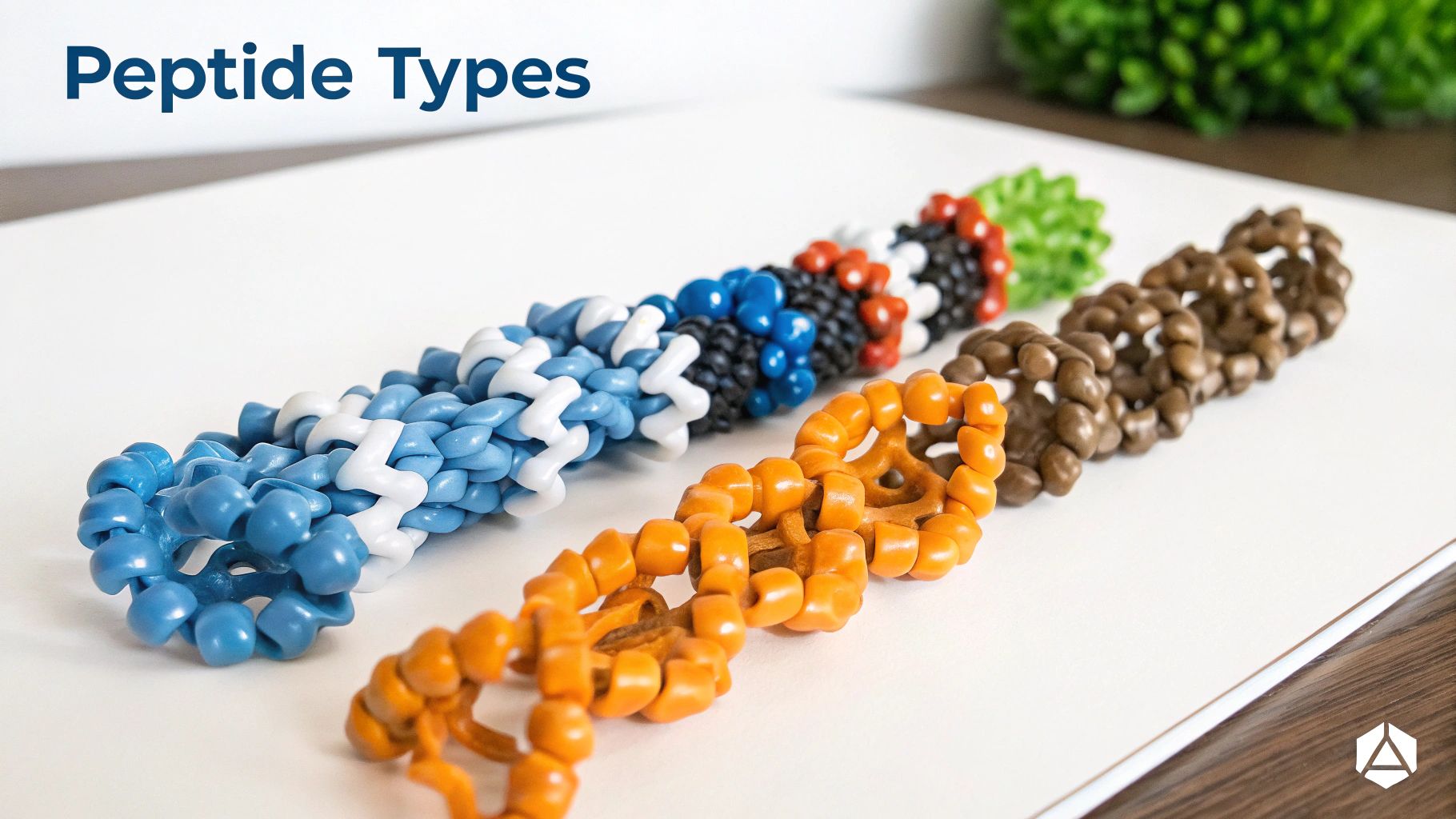
When you start looking into weight loss peptides, it’s easy to get swept up in stories of incredible transformations. But what can you genuinely expect? It’s a fair question. While these medications are powerful tools that can deliver amazing results, they aren’t magic pills.
Think of peptide therapy as giving your body a major metabolic upgrade. It works behind the scenes to turn down the volume on your hunger signals and fine-tune how you burn energy. But the final outcome—the number on the scale—really hinges on what you do with that newfound advantage.
Putting the Percentages Into Perspective
Clinical trials often talk about weight loss in percentages, which can feel a bit abstract. So, let’s break down what a common figure like a 15% body weight reduction—often seen with potent peptides like Tirzepatide—actually means in the real world.
- If you start at 220 pounds, a 15% loss is 33 pounds.
- If you start at 250 pounds, that same 15% loss works out to 37.5 pounds.
These are life-changing numbers, no doubt. But it’s vital to remember that these are averages from studies where participants followed structured diet and exercise plans. This is also why widespread shortages of brand-name drugs have pushed so many people to find other peptide options. Our guide on navigating the shortage dives deeper into this issue.
The Factors That Will Shape Your Journey
Your personal results with weight loss peptides aren’t set in stone. Several key factors will influence what you see on the scale and in the mirror.
Key Insight: Your success isn’t just about the peptide itself. It’s a partnership between the medication’s biological effects and your daily habits. When both are working in harmony, that’s when you see real, lasting change.
Here are the biggest variables that come into play:
- Your Starting Point: People with a higher initial body weight often experience a more noticeable drop in pounds, especially at the beginning.
- Peptide and Dosage: A dual-action peptide like Tirzepatide might produce different outcomes than a single-action one like Semaglutide. Your doctor will also carefully adjust your dose to maximize results safely.
- Your Lifestyle Commitment: This is the big one. The absolute best results happen when you pair the peptide with a nutrient-rich diet and regular physical activity. One amplifies the other.
How Your Overall Health Plays a Role
Your unique health profile is another huge piece of the puzzle. For example, clinical data clearly shows that results can vary depending on conditions like pre-existing diabetes.
For someone with type 2 diabetes, GLP-1 peptides combined with lifestyle changes typically result in a weight reduction of around 4% to 6%. In contrast, non-diabetic individuals using the same peptides and making the same lifestyle efforts often achieve more significant losses, somewhere in the 6% to 17% range.
This just goes to show that these peptides work within your body’s specific biological landscape. The real goal isn’t just to lose weight now, but to use these powerful tools to build sustainable, healthy habits that will keep you at a healthier weight for good. By setting realistic goals and committing to the entire process, you put yourself in the best position to achieve powerful, lasting results.
Navigating Side Effects and Safety

Whenever you start a new treatment, and that absolutely includes peptides for weight loss, the top priority has to be safety. The good news is that these therapies are usually very well-tolerated. Still, knowing what to expect in terms of side effects is crucial for a smooth and successful experience.
Most of the common side effects from GLP-1 peptides are gastrointestinal. This makes perfect sense when you remember how they work—by slowing down your digestive system to help control your appetite. These issues are typically mild and fade as your body gets used to the medication.
Common Side Effects and How to Manage Them
So, what might you feel when you first start? The most common issues are directly tied to that digestive slowdown, but thankfully, there are simple ways to manage them as your body adjusts.
You might run into:
- Nausea: This is probably the most common one, especially right after you start or increase your dose. The trick is to eat smaller, more frequent meals so you never feel uncomfortably full.
- Constipation or Diarrhea: Since digestion speed is changing, things can swing in either direction. The best defense is staying hydrated and making sure you’re getting plenty of fiber.
- Bloating and Gas: When food hangs around a bit longer, some bloating is natural. I’ve found that steering clear of particularly greasy, fatty, or super sugary foods makes a huge difference here.
By far, the best way to sidestep these issues is to start with a very low dose and increase it slowly over several weeks. This “start low, go slow” method gives your body a chance to adapt, which dramatically lessens the intensity of any side effects.
Understanding More Serious Risks
While much less common, there are a few more serious risks to be aware of. Not everyone is a candidate for peptide therapy, and this is exactly why a thorough medical consultation is non-negotiable.
A completely open and honest conversation with your doctor is the foundation of any safe treatment. They need to review your entire health history to determine if peptides are the right choice for you.
For example, a personal or family history of specific conditions like medullary thyroid carcinoma (MTC) or Multiple Endocrine Neoplasia syndrome type 2 (MEN 2) would likely rule you out. Your doctor will screen for these and other contraindications before ever writing a prescription. For a much deeper dive, our guide on why peptide therapy is safe under professional supervision is a great resource.
At the end of the day, using weight-loss peptides safely boils down to one thing: professional medical oversight. When you work with a qualified provider, you get a proper diagnosis, a plan built for you, and ongoing support. That partnership is what allows you to hit your goals while keeping your long-term health front and center.
How to Start Peptide Therapy Responsibly
If you’re considering using peptides for weight loss, the most important thing you can do is start the right way. This isn’t something you should ever try to figure out on your own. Real, effective peptide therapy always begins with professional medical guidance.
It’s tempting to look for quick fixes from unregulated online sellers, but the risks are huge. Peptides from these sources often have zero quality control. You have no way of knowing if the product is pure, contaminated, or even what it claims to be. Going down that road is dangerous and defeats the entire purpose of improving your health.
The Critical First Step: Your Medical Consultation
The only safe way forward is to work with a licensed medical professional. You can do this through a local clinic or a trusted telehealth service that specializes in hormone and peptide treatments. This initial consultation isn’t just a box to check—it’s the foundation of a safe and successful plan.
During this vital evaluation, your provider will take a deep dive into your health. This entire process is designed to protect you and make sure the therapy is a good fit for your unique situation.
Your consultation should always include:
- A Detailed Health History Review: The doctor will go over your personal and family medical history, current health conditions, and any medications you’re taking.
- A Discussion of Your Goals: This is where you talk about what you want to accomplish. Is your main focus weight loss, or are you also hoping to maintain muscle mass or boost your energy levels?
- A Professional Medical Assessment: Based on all this information, the provider will decide if you’re a good candidate for peptide therapy and which specific protocol would be the safest and most effective for you.
Crucial Takeaway: A valid prescription from a licensed healthcare provider is non-negotiable. It’s your guarantee that the treatment is medically sound for you and that the peptides you get come from a legitimate, high-quality pharmacy.
Partnering With a Specialized Telehealth Provider
For a lot of people, telehealth clinics provide a convenient and private way to get expert medical care. Reputable platforms like Elite Bioscience have a clear, structured process that prioritizes patient safety from beginning to end.
As you can see, a professional telehealth provider guides you directly toward a proper medical consultation. This approach takes the guesswork and danger out of the equation, so you don’t have to navigate the risky unregulated market by yourself. It puts your health and safety exactly where they should be: first.
Common Questions About Weight Loss Peptides
Once you get a handle on the science, the practical questions start popping up. It’s only natural. You want to know what this really looks like day-to-day, what it costs, and what the long-term picture is. Let’s get into the real-world answers to the questions we hear most often.
A big one is whether you’re signing up for a lifelong treatment. The honest answer is: it depends. The best way to use these medications is as a powerful tool to reach your target weight while you build rock-solid, healthy habits.
Some people successfully taper off after hitting their goals. Others might stick with a lower maintenance dose to help keep the weight off, especially if they have underlying metabolic issues that aren’t going away. It’s a very personal decision made with your doctor.
What Happens If I Stop Taking Peptides?
This is probably the most important question to ask. If you stop taking a peptide like Semaglutide or Tirzepatide and slide back into old eating and exercise patterns, you’ll almost certainly regain the weight.
Think of the peptide as a set of training wheels for your metabolism and habits. It quiets the constant “food noise” in your head and gets your body’s systems working correctly, which makes it so much easier to choose healthier foods and be more active. The real goal is to use this time to lock in those new routines. Your success, long after the medication, depends entirely on the lifestyle you build during treatment.
Key Takeaway: Peptides aren’t a one-and-done cure. They’re a catalyst. The lasting results come from your commitment to the new, healthy habits you form while you have this powerful support. This is why ongoing medical guidance is so crucial for mapping out a long-term strategy that actually works.
Are Weight Loss Peptides Covered by Insurance?
Navigating insurance for weight loss peptides can be tricky, and frankly, a bit of a maze. Coverage varies wildly. While some insurance plans might cover brand-name GLP-1s, it’s never a guarantee. It often comes down to your specific diagnosis—for example, coverage is often better for type 2 diabetes than for obesity alone—plus your provider and your plan’s fine print.
The unfortunate reality is that many people discover their insurance won’t cover these medications for weight management, leaving them with very high out-of-pocket costs. This is a major reason why many turn to specialized medical clinics for compounded peptides. Under a doctor’s care, this can be a more direct and affordable path. The first step is always to call your insurance provider directly to get a clear picture of what your plan covers.
Ready to see how medically supervised peptide therapy could fit into your health plan? The team at Elite Bioscience is here to guide you through the process safely and effectively. Learn more and get started today.






